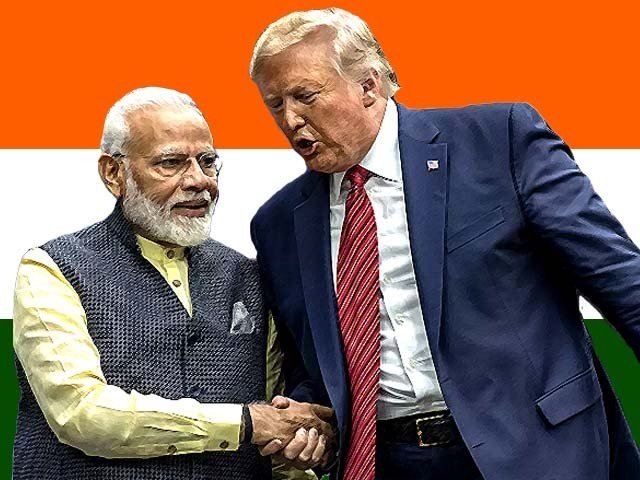
HOPE Dinning Room Food Service – April 24th, 2020
The event has been CANCELLED due to COVID-19.

The event has been CANCELLED due to COVID-19.

The event has been CANCELLED due to COVID-19.

While American President Donald Trump and Indian Prime Minister Narendra Modi were busy tooting each other’s horns this week, Delhi was burning. The Hindu-Muslim riots were emblematic of the violence and sectarian divide which has gripped India in recent times. Yet, it appears that Trump and Modi are rather unbothered by this escalation. Trump said that the incident was “up to India” to handle and that Modi had worked “really hard” to ensure religious freedom, while Modi simply addressed the matter through one tweet. Although both Trump and Modi claim to be teetotalers, to me at least, they always look drunk (perhaps on power). After all, how can a sober individual tell so many lies, so shamelessly, and bully his critics and opponents publicly without any inhibitions? They are high on the unassailable authority each one of them wields in their respective countries and parties; the Republican party in Trump’s case and the Hindu nationalist Bharatiya Janata Party (BJP) for Modi. To ensure that they always stay cocooned within their megalomaniac personae, both are surrounded by sycophants and have ruthlessly sired a cult of loyalty and glorification around themselves. Trump’s trip to India only helped prove this point.
Cameras and booming rhetoric take precedence over action for both heads of state who apparently share a fetish for being cheered on by mammoth crowds of adoring and adulating followers, as evidenced by the “Namaste Trump” event. Regardless of their highly embellished talk of “Make America Great Again” and “Make in India”, both have used countries hostile to their own to help manipulate the voting masses and thus stay in power. While Modi and his political machinery openly uses Pakistan repeatedly to distract the focus of the Indian masses from the real issues plaguing India, Trump apparently has no shame in taking Russia’s help under the table while presenting Iran as the great external threat to the west.
Although Trump’s India visit did not result in a signing of the much talked about trade deal, the simple truth of the matter is that as far as Trump and Modi are concerned, the trip achieved its objective – boosting the egos of both the leaders. Trump knows that the pictures of him speaking to thousands in Ahmedabad will play well with his vote bank back home. Modi, having already won the election last year, needed this overly zealous show of support from Trump to try to silence those in India who have continued to be critical of many of Modi’s recent polices. Hence, the riots in Delhi couldn’t dampen the mood of either leader.
Both Trump and Modi boast of their physical strength like bullies in grade school and unabashedly accuse others for their nations’ ills. Trump points his finger at immigrants from Latin America and Muslim majority countries while Modi aims his accusations at non-Hindus in India, particularly Muslims. It is not surprising, therefore, when they excuse violence and vitriol against all those who are not interested in joining their respective fan clubs. Nothing showcases this more clearly than Charlottesville for Trump, and the unabated attacks on Muslims and the passing of the Citizenship Amendment Act (CAA) for Modi.
Notwithstanding the distance between their geographies and differences in their respective families and backgrounds, both have shown little respect for women too. Trump has demonstrated it repeatedly throughout his life by how he speaks about and uses women. Modi has demonstrated this by how little he has done to aggressively pursue rapists and deal with the increasing rapes and assaults against women, with many claiming that the rape crisis has worsened during the Modi regime. Another remarkable similarity between the two men is their practice of belittling others to attain self-aggrandising and grandstanding imperatives for their nationalistic autocracies.
Yet, despite having so much in common, their respective regimes have had different impacts on their economies. Trump inherited a rising economy from his predecessor which has continued to improve under him. In fact, that is going to be one of his major selling points during this election cycle in the United States. On the other hand, in India, the exact opposite has occurred under Modi as the juggernaut Indian economy now finds itself facing an economic slowdown which will have far-reaching effects. While Modi may choose to bury his head in the sand when it comes to addressing the Delhi riots, shouldering responsibility for the Indian economic downturn is unavoidable.
The president and the prime minister have created vicious divisions among their peoples only for their personal benefit, but in the process have caused irreparable harm to the social fabric of the countries they lead. Whether Trump and Modi realise it or not, the negativity their words and actions breed have global ramifications. Adolf Hitler’s rise in Germany before World War II hinged on a manufactured fear of physical and economic harm his brigades of hooligans created among those who disagreed with him. Modi and Trump have succeeded in using the same tools to threaten and scare their opponents while the majority, just like in that era, choose to stay silent. If they continue to do so, it will be at their own peril.
————————-
This column was published online by the https://blogs.tribune.com.pk/ on January 27, 2020.
I am a Sikh.
A turban is an article of faith for the Sikhs. It signals honesty, service and compassion to those in need. But the opposite has been perceived in our country, especially after 2001.
Many of my fellow Americans continue to mistake Sikhs for those they aren’t, simply because of their appearance.
From bullying in schools to discrimination in the workplace to becoming victims of violence, Sikhs continue to suffer because fellow citizens connect their appearance to terrorism.
As a result, more and more Sikhs are practicing their faith without its most visible article — the turban and the unshorn hair under it.
The first American killed by a fellow citizen in vengeance after 9/11 was a turbaned Sikh in Mesa, Arizona on Sept. 15, 2001.
Last September, in Texas, a routine traffic stop cost turbaned deputy Sandeep Dhaliwal his life. Another turbaned Sikh in Tracy, California, Paramjit Singh, was stabbed to death during a routine walk in the park last August. The list of such brutalities against turbaned Sikhs goes on.
Even America’s largest employer, the military, for decades did not allow Sikhs to serve with their articles of faith despite their rich and proud warrior history and inspiring record of service in the armed forces of various countries. More than 80,000 Sikh soldiers laid down their lives serving alongside Allied forces during World Wars I and II.
In 2017, after years of lawsuits and pressure, the U.S. Army changed its policy to allow observant Sikhs and members of other religions to wear beards and head coverings provided permission is applied for in advance. The NYPD now allows Sikh officers to wear turbans, joining a few other local law enforcement agencies with similar policies.
Yet, while some Sikhs have fought long and hard for the right to wear the turban, others have voluntarily abandoned this tradition, perhaps because of its possible impact on their personal or professional lives.
For example, here in Delaware, there are several prominent Sikh doctors but not one who wears a turban — despite their towering presence on the trustee and management boards of the state’s two gurdwaras, which are Sikh temples.
For Sikh women, life is easier on this count because a turban is optional for them. However, even without a turban, belonging to the Sikh faith or having brown skin can impede or even disqualify their participation in mainstream activities.
This is something Nikki Haley (nee Nimrata Nikki Randhawa), former governor of South Carolina and U. S. Ambassador to the United Nations, reportedly learned in her hometown of Bamberg, South Carolina, when she was 5.
Nikki’s parents had attempted to enter her in the “Miss Bamberg” contest but her application was rejected because she did not qualify for either crown: black or white. Eventually, a few years before entering politics, she changed her religion from Sikhism to Christianity.
It is ironic that in some parts of the world, the turban is viewed as a sign of security, not a threat. In India, the Sikh homeland, a single woman, or anyone who feels insecure, is more likely to hire a turbaned Sikh driver because of their well-known dedication to serving the needy and protecting the weak and vulnerable.
So in 2020 and beyond, how can Sikhs and other religious groups correct the misconceptions that appearances generate in those who are ignorant, hateful and impulsive?
Only through education and participation in schools, workplaces, houses of worship and communities — and a strong media presence — can observant Sikhs encourage and expect understanding.
Let’s hope that someday all Sikhs can base their decision to wear or not wear a turban purely on personal choice and not on external influences or threats.
– – – – – – – – – – – – – – – –
This column was published online by the www.delawareonline.com on January 24, 2020.

DSAC and friends will cook and serve our homeless and needy friends on Friday, January 24th, 2020 at 300 Marrows Road, Newark, DE 19713
Recent Comments